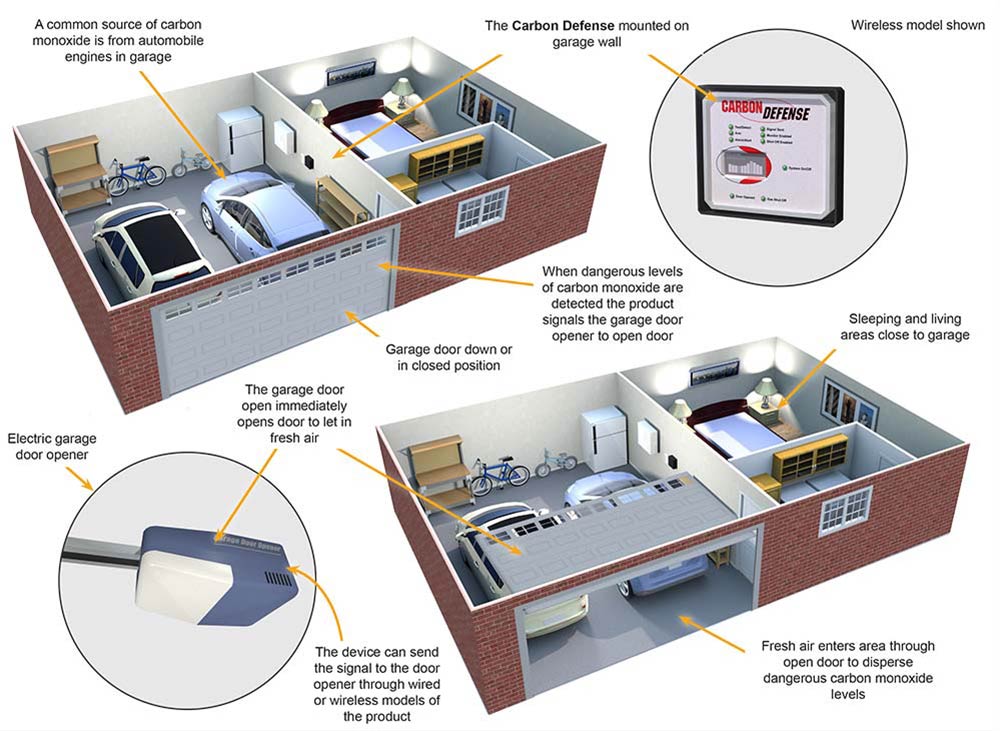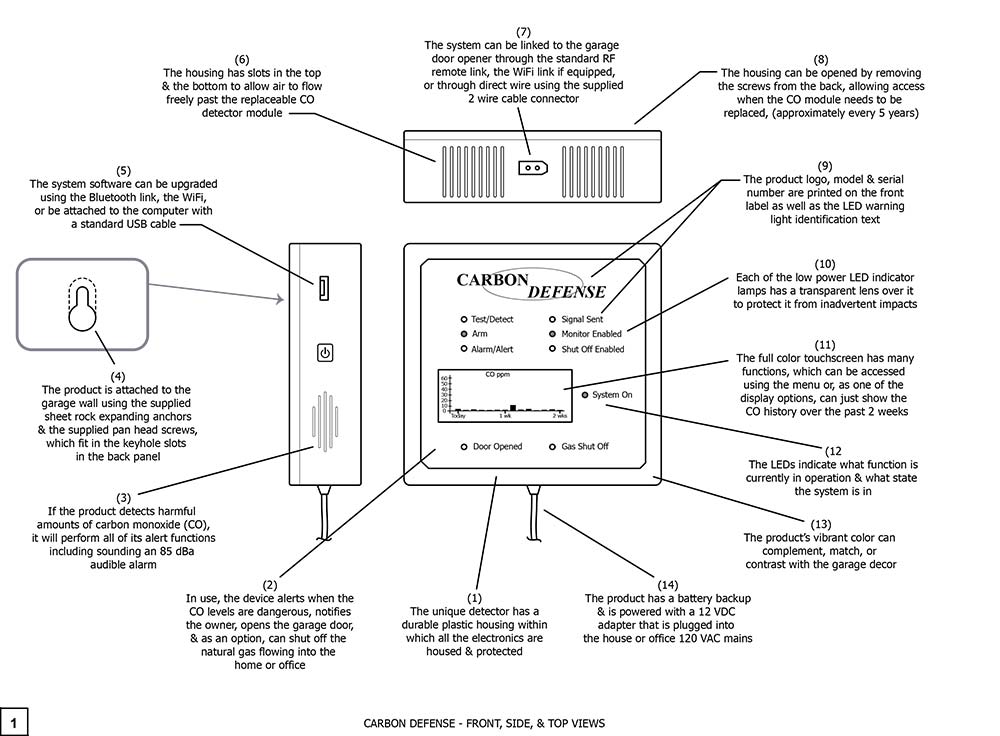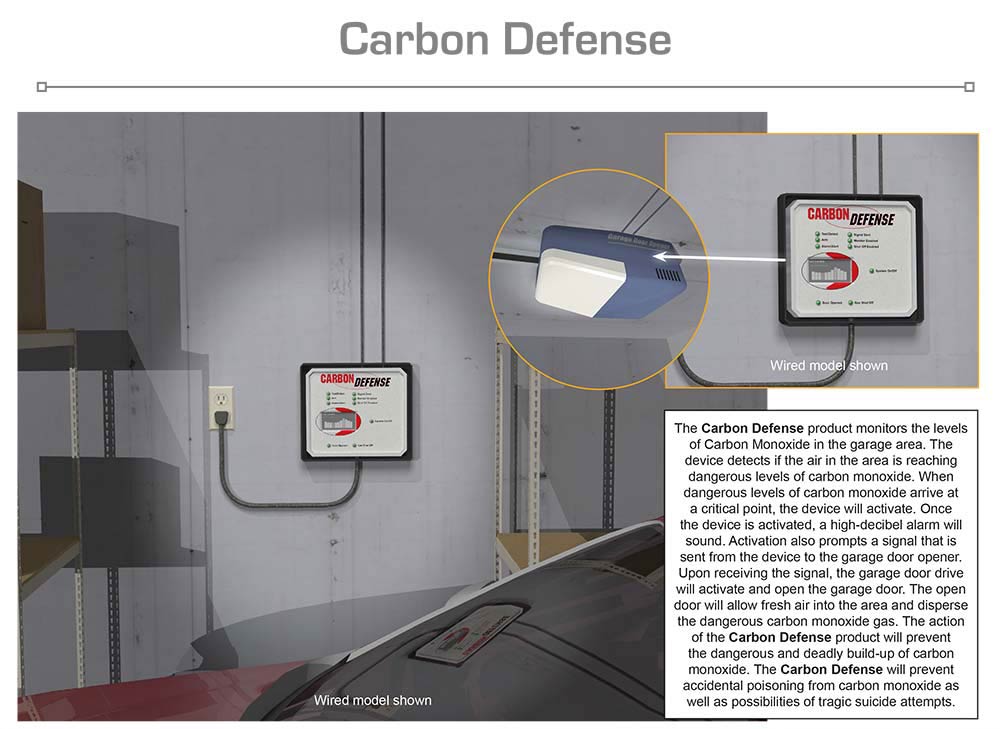
Carbon Defense
DESCRIPTION:
Carbon monoxide (CO) is a color and odorless gas that can be produced by the burning of carbon based fuels such as gasoline or natural gas. There are other sources of carbon monoxide, but the most likely encounter by humans is through the use of carbon- based fuels. The adverse effects of the gas are the combining with hemoglobin to form carboxyhemoglobin in the blood. This condition prevents the blood from carrying oxygen to the cells. The inhalation of carbon monoxide can result in loss of consciousness, arrhythmias, seizures and eventually death. The average for dangerous levels of carbon monoxide exposure is at 100 parts per million for the human body.
Lower levels of carbon monoxide poisoning can cause persistent headaches, lightheadedness, depression, memory loss, confusion, nausea, and vomiting are among the well-known symptoms. Long-term exposures to low levels of carbon monoxide can cause permanent health problems and may lead to early death in some cases.
Higher levels of carbon monoxide poisoning are almost always fatal unless the situation rectified in time. Initial treatment for carbon monoxide poisoning is to remove the affected person from exposure immediately. CPR may be immediately required for those who have lost consciousness. The administering of oxygen will accelerate the separation of carbon monoxide from the carboxyhemoglobin reverting it to hemoglobin. The process for returning to hemoglobin takes time so that time is of the essence when exposure to carbon monoxide has occurred. Failure to administer oxygen or exposing the affected persons to fresh in time often results in fatal outcomes or permanent health issues.
Prevention of carbon monoxide poisoning is always the best route when the danger of exposure is a possibility. Safe operation of appliances, heaters, fireplaces, and internal combustion engines is a fundamental public health issue. Carbon monoxide detectors are as important in the home as are smoke alarms.
The internal combustion engine should never be left running in the garage. The carbon monoxide levels can build up so quickly that a person may lose consciousness before they realize there is a problem. A garage that is attached to the house is especially dangerous when an automobile is left running in the garage. The CO leaks into the house eventually and even well-sealed homes and buildings are susceptible. It is only a matter of time before the CO levels become dangerous for any enclosed space like a garage if the source is not removed. Unfortunately, the known lethality of leaving a running car in the closed garage has been used by persons to take their own lives. The situation of suicides by CO poising only heightens the reality of the susceptibility of CO poisoning by the internal combustion engine in a closed garage.
The Carbon Defense is an innovative and unique solution to carbon monoxide buildup in a closed garage. The Carbon Defense is mounted in the garage on a convenient wall. The Carbon Defense continuously monitors carbon monoxide levels in the garage. In the event of carbon monoxide levels reaching a dangerous level for a prescribed amount of time, the Carbon Defense will sound a high-decibel alarm while simultaneously sending a signal to the electric garage door opener to open the garage door. The large size of the garage door opening will significantly increase the amount of fresh air into the garage instantly. The fresh air will disperse and dilute the carbon dioxide rendering a much safer environment. The high-decibel alarm will alert anyone in the vicinity to check the source of the CO gas and take proper action. The device will also alert the user via a text message that the Carbon Defense has been activated so that they may take appropriate action. If no action is taken within the arranged amount of time, emergency services are contacted and provided with specifics about the location and incident details. The Carbon Defense will eliminate deadly scenarios dealing with carbon monoxide build up garages and will prevent the poisoning by this lethal gas whether accidental or otherwise.
SPECIFIC, UNIQUE FUNCTIONS OF INVENTION:
- Wired model plugs directly into power outlet and is hardwired into the garage door opener
- Battery powered model with low voltage wires leading directly to door opener
- Wireless model links to door opener via transmitter/receiver (no wires needed)
- Can be installed with remote unit on gas valve to shut off gas when activated
- Device is capable of connecting to any CO source such as gas stoves and heaters.
- Remote shut of CO producing appliances through device as an option
- Phone App for control and notifications
- Programmable device
- Works with any electric or battery back-up garage door opener
- High-decibel alarm
- Automatically opens garage door when activated
- Contacts user and emergency services
- Prevents tragic accidents
- Prevents persons intending self-harm or destruction
PRODUCT COMPONENT CLARIFICATION:
The “Carbon Defense” is an innovative home safety product that has been designed to warn the user/owner of the dwelling that a dangerous level of carbon monoxide (CO) has or is occurring in the garage, sounds an audible alarm, and opens the garage door to alleviate the problem. The plastic housed product mounts on the wall of the garage, uses the dwelling mains, and is linked to the house via Wi-Fi, Bluetooth, and/or hard wire. The battery backup insures the product works even if the power is out for a few hours.
Currently, most garages are not monitored for carbon monoxide levels. This is primarily due to cost and because most often the audible alarm cannot be heard within the dwelling. CO is a deadly chemical as it is odorless and colorless. Above certain levels, it kills people and pets. The initial onset of CO poisoning is also very hard to recognize because the initial symptoms are flu-like. There are many causes of poisoning that are in located in the garage, such as internal combustion engines on lawn equipment, gas powered generators, vehicles inadvertently, or on purpose, left on, gas space heaters, gas appliances, gas water heaters, etc. The CO levels build up rapidly if the garage doors are closed, and if not detected, can cause serious illness or death.
The “Carbon Defense” resolves almost all of these problems by detecting the level of CO in the atmosphere within the garage and onboard microcomputer comparing that level to a look up table in the device. If the CO in garage exceeds any of the following levels, the system calls, texts, or emails the renter/homeowner, engages the 85 dBa audible alarm, and then opens the garage doors to dramatically improve the ventilation and lower the CO level within the garage. If there is no response by the homeowner within 5 minutes, the designated authority is called, texted or emailed. As an option, the system can control a solenoid valve on the incoming gas line and shut that off. The alerting action continues until the system is reset, either manually or through the Bluetooth, Wi-Fi, or cellular phone link. The system is powered by a supplied 12 VDC adapter that plugs into the dwelling 120 VAC mains. The system controls the garage door, and the optional natural gas valve, through the use of Wi-Fi, Bluetooth, and/or hard wire.
OSHA suggests that an exposure to between 9 and 50 ppm for up to 8 hours every 12 months is considered to be safe for adult humans.
The system will alert if any of the conditions described below are exceeded
Per Underwrites Laboratory Standard 2034
70 ppm for 4 hours
150 ppm for 50 minutes
400 ppm for 15 minutes
The plastic housing: The 2 housing sections are injection molded from polycarbonate ABS plastic. This plastic is very durable, is highly resistant to drop shocks, is highly resistant to household or automotive chemicals, and is typically used in this type of application. The housings can be supplied in almost any vibrant color, so a distinctive color may be chosen to enhance the product recognition factor, which can dramatically improve the market adoption of the product. The polycarbonate LED lenses are adhesively bonded in place. The housing is held together using supplied stainless steel machine screws. The mounting keyholes are molded into the back section. The system is supplied with drywall anchors and pan head fasteners.
- The logoized label is printed on the metalized Mylar with an adhesive back. The logo and the text identifying the LEDs in printed on the shiny surface. The label is machine placed after the protective back is stripped off and the front section of the system is placed in the jig underneath the label.
The printed circuit boards (PCB): The PCB for the device fabricated to the final assembler’s requirements in a world class contract electronic assembler facility. The standard thickness, double sided FR4 circuit board material is populated with surface mounted components where possible. Any through-hole devices are inserted after the surface mounted assembly, soldering, and cleaning. The circuit board is designed to have all the components oriented so they can be mounted with the LED illuminators projecting out of the lenses mounted in the housings. After assembly, the PCBs are protected with a moisture adsorption preventive conformal coating. The electronics listed below, but not limited to the following, are included in the standard system without the gas line shutoff capability.
- The controlling computer: Dual core, 1.3 GHz ARM based computer chipset. This is from a generation or two back cellular phone inventory to reduce programming and device cost. The product is supplied with 16 GB of memory and 1 GB of RAM.
- The touch screen display: This display is a LED backlit IPS LCD capacitive touch screen with full color capability. The screen is 4.0” diagonal at 326 pixels per inch. It is protected with Corning Gorilla GlassTM with oleophobic coating.
- LEDs: These low current LED devices are lighted using a remote LED driver controlled by the computer. They indicate status and current conditions of the device to aid in quickly determining the condition of the system. They work in conjunction with the touch screen display.
- Switch: The on/off switch is a sealed tactile membrane switch.
- The WiFi link: 802.11 a/b/g/n, dual band chip set.
- The Bluetooth link: 5.0, A2DP, and LE (long range) capable chip set. This unit can send and receive up to 300’ in free air. Somewhat less within building confines but more than sufficient for this application.
- Garage door RF link: This transmitter operates on the security + 2 garage door opener standard at 310, 315, and 390 MHz.
- The audio alert: This small piezoelectric sound emitter provides a low priority alarm at 2.0 KHz at 85 dBa. It is programmed to emit 2 medium length pulses repeating every 5 seconds to conserve energy and draw attention.
- The 120 VAC cord & plug and smart charger: This section of the PCB has a power supply and smart charger chip. It takes the 12 VDC power derived from the building 120 VAC mains, converts it to the 2 levels of DC used within the system. One drives the audible alarm and the other is used to charge the Li-Ion battery. The smart charger monitors the battery temperature and will not charge the battery if it is elevated in temperature. The adapter has a 6’ cord to allow convenient connection to the device.
- Li-Ion battery: This very high current density battery employs the latest in Li-Ion technology. It is packaged to fit in the housing. When fully charged, the battery will support normal operation over approximately24 hours after loss of external power.
- The CO detection module: This detection module is designed with connector on the PCB and plug in base using spade connectors. This allows easy replacement by tradesmen or talented do-it-yourselfers every 5 years. The detection modules employ metal oxide semiconductor sensors. These sensors detect changes in the conductivity of the chip as it comes into contact with the metal oxide surface.
The application program: This program is written to allow the renter/homeowner to set up the system and determine the contact numbers and pre-programmed response for the product upon notification of an alert condition. The App is downloaded from the system manufacturer’s website at no cost when the system is purchased. The App can be used on any smartphone, tablet, or laptop computer with Wi-Fi or Bluetooth capability.
The Carbon Defense system is designed to be aesthetic and effective in the application. The relative ease of manufacture and the moderately inexpensive components provide good marketability for the manufacturer. The user benefits from improved CO detection and alerting capabilities, which should provide considerable market interest in the product.
The invention is illustrated in the following drawings of the essential points as explained to us in the documentation.

Drawing 1, Block 1: Carbon Defense – Front, Side, And Top Views
(1) The unique detector has a durable plastic housing within which all the electronics are housed and protected.
(2) In use, the device alerts when the CO levels are dangerous, notifies the owner, opens the garage door, and as an option, can shut off the natural gas flowing into the home or office.
(3) If the product detects harmful amounts of carbon monoxide (CO), it will perform all its alert functions including sounding an 85 dBa audible alarm.
(4) The product is attached to the garage wall using the supplied sheet rock expanding anchors and the supplied pan head screws, which fit in the keyhole slots in the back panel.
(5) The system software can be upgraded using the Bluetooth link, the Wi-Fi, or be attached to the computer with a standard USB cable.
(6) The housing has slots in the top and the bottom to allow air to flow freely past the replaceable CO detector module.
(7) The system can be linked to the garage door opener through the standard RF remote link, the Wi-Fi link if equipped, or through the direct wire using the supplied 2 wire cable connector.
(8) The housing can be opened by removing the screws from the back, allowing access when the CO module needs to be replaced (approximately every 5 years). The controlling computer will also remind the user on the display and a chirp every 30 seconds from the audible alarm.
(9) The product logo, model, and serial number are printed on the front label as well as the LED warning light identification text.
(10) Each of the low power LED indicator lamps has a transparent lens over it to protect it from inadvertent impacts.
(11) The full color touchscreen has many functions, which can be accessed using the menu or, as one of the display options, can just show CO history over the past 2 weeks.
(12) The LEDs indicate what function is currently in operation and what state the system is in.
(13) The product’s vibrant color can complement, match, or contrast with the garage décor.
(14) The product has a battery backup and is powered with a 12 VDC adapter that is plugged into the house or office 120 VAC mains.
Although a single embodiment of the invention has been illustrated in the accompanying drawings and described in the above detailed description, it will be understood that the invention is not limited to the embodiment developed herein, but is capable of numerous rearrangements, modifications, substitutions of parts and elements without departing from the spirit and scope of the invention.
This document has been prepared for the manufacturer’s elucidation. The manufacturer’s decision makers should consider this product for licensing (providing intellectual property protection for their sales of the product in return for a royalty payment for a period of years) or an outright purchase of the patent for a negotiated fee. The inventor and his team are standing by to consider offers for licensing or outright purchase of the patent.


